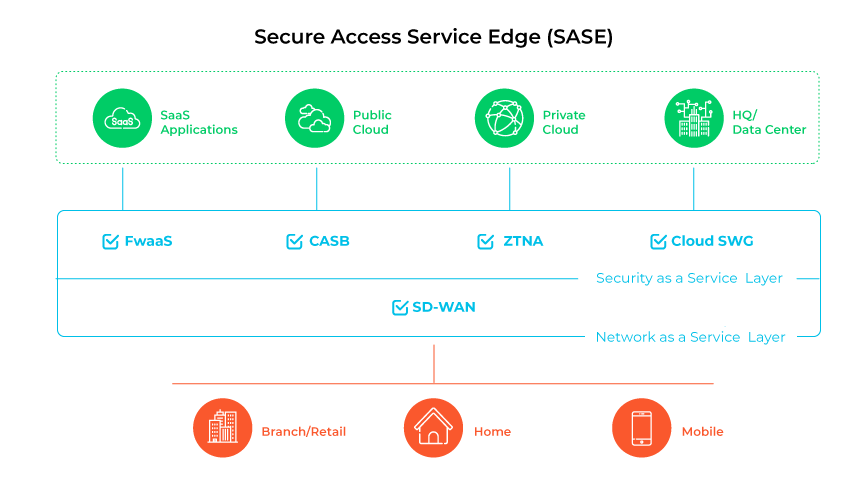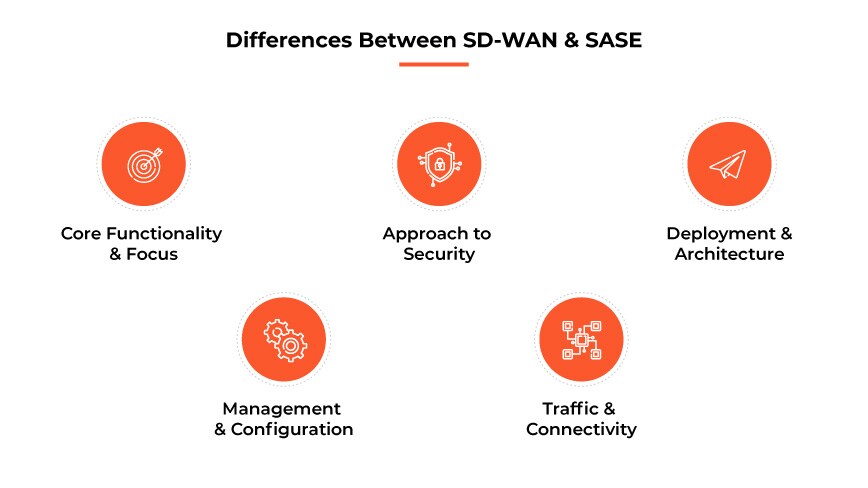SD-WAN vs. SASE: What’s the Difference?
SASE integrates SD-WAN with cloud-based security functions, providing a dynamic network security solution that shifts the perimeter to cloud-native capabilities. In contrast, SD-WAN employs software-defined networking principles focusing on securely connecting users across locations, primarily linking branch locations to a centralized private network.
What Is a Secure Access Service Edge (SASE)?

A secure access service edge (SASE) integrates SD-WAN with security functions, such as SWG, cloud access security broker (CASB), FWaaS and ZTNA in a single cloud-based service. SASE architecture provides a cloud-delivered network and security infrastructure.
This structure allows organizations to connect users, including remote workers, to the nearest cloud gateway. Through this, they gain secure access to applications and achieve complete traffic visibility across all ports and protocols.
SASE greatly simplifies network management and security. It shifts the perimeter from a traditional data center boundary to cloud-based capabilities. These capabilities are deployable as required, making it a streamlined alternative to traditional perimeters secured with multiple devices.
Being cloud-based, SASE solutions offer a dynamic network, which adjusts to business needs, emerging threats and future technological changes.
What Is a Software-Defined Wide Area Network (SD-WAN)?

SD-WAN employs software-defined networking principles to oversee wide area networks (WANs) efficiently. SD-WAN technology ensures secure connections for users across multiple locations, with enhanced performance and centralized management.
Unlike traditional WANs that depend on manual rule creation for routers, SD-WAN is application-centric and virtualized, swiftly adapting to changes and offering better security. It's crucial to accessing cloud applications securely.
SD-WAN architecture revolves around a centralized control plane, streamlining rule and policy deployment across the network. This approach minimizes individual device management. Furthermore, SD-WAN supports diverse connection types, like MPLS and broadband, bolstering bandwidth and performance while simplifying administration.
What Are the Differences Between SD-WAN and SASE?

Core Functionality and Focus
SASE and SD-WAN serve as networking technologies aiming to improve connectivity across geographically spread endpoints. However, their functions and main focus areas differ.
SASE represents a cloud-based solution that converges both SD-WAN and SSE to connect individual mobile users and remote networks directly to the cloud-delivered security solution. Whereas SD-WAN, derived from software-defined networking (SDN) principles, primarily connects branch locations/remote networks through multiple WAN connections to data centers, internet and SaaS applications.
Approach to Security
While SD-WAN possesses some security functionalities, it often requires third-party integrations, like cloud access security brokers, for comprehensive protection. SASE, on the other hand, naturally integrates both networking and security services, offering built-in security features, such as Zero Trust security.
Deployment and Architecture
SD-WAN offers flexible deployment, allowing businesses to choose between physical, software or cloud-based connections. It holds the organization's data center at its core, adhering to traditional networking concepts. Conversely, SASE employs a distributed, cloud-based architecture, viewing the data center as another service edge.
Traffic and Connectivity
The methods of handling traffic and connectivity further distinguish these technologies. SD-WAN focuses on linking branch locations to an organization's central network. SASE, with its cloud orientation, directs traffic via globally dispersed points of presence (PoPs), eliminating the need to backhaul traffic through central data centers.
Management and Configuration
SD-WAN primarily configures and provisions network parameters from a centralized controller, whereas a SASE solution can manage both networking, security and visibility from a central management console while automating all these operations seamlessly.
What Are the Similarities Between SD-WAN and SASE?

Shared Goals
SASE and SD-WAN both aim to enhance the connectivity of geographically dispersed locations or end users to an organization's network resources. Their primary objective is to provide scalability and ease of management for wide area networks.
Cloud-Based Solutions
Both SASE and SD-WAN offer cloud-based functionalities. They can seamlessly connect branch locations to cloud resources, providing flexibility, scalability and potential cost savings. Either can be used with various cloud services or WAN connections, reflecting the evolving nature of today's network architectures.
Virtualized Infrastructure
SASE and SD-WAN use virtualized technologies. Instead of relying on traditional fixed-function proprietary hardware, they use software-defined solutions. While SASE runs its networking and security functions within the cloud or data centers, SD-WAN employs software-defined nodes, including customer-premises equipment (CPE).
Enhancing Network Connectivity
A fundamental similarity is the approach to network connectivity. Both employ virtual overlay networks to automate routing, optimizing network traffic based on predefined policies and real-time network conditions. This not only enhances the efficiency of data traffic but also ensures a consistent user experience.
Geographic Scalability
The technologies are designed to cater to vast geographic areas, ensuring businesses can expand and scale operations without network limitations. Availability in various regions provides organizations with the flexibility to grow their footprint while maintaining optimal network performance.
Control and Management
Both SASE and SD-WAN solutions can be controlled remotely. This centralized control allows network administrators to manage and optimize the network from any location, ensuring consistent policies and configurations across the entire network infrastructure.
How to Choose Between SASE and SD-WAN

Choosing between SASE and SD-WAN begins with understanding the preferred deployment model. There exist two primary options: on-premises and cloud-based. On-premises SASE and SD-WAN necessitate on-site hardware, offering greater control over the network. However, this also entails potential increased cost and complexity
In contrast, cloud-based deployments are often managed by the provider, allowing internal IT teams to direct their focus elsewhere. Such solutions generally offer enhanced scalability and ease of deployment compared to on-premises alternatives.
Determining Connectivity Needs
Identifying connectivity requirements forms a crucial step. This involves understanding bandwidth needs and support for multiple links or connections.
Evaluating Security Needs
Security remains paramount for any organization. Identifying the necessary security features and any support for advanced security protocols, like IPsec, becomes essential when choosing between the two technologies.
Gauging Management and Insight Requirements
Management capabilities differ between solutions. Assessing the degree of control needed over the network, along with any requirements for detailed insights and reporting, can influence the decision-making process.
Budget Considerations
Budget constraints and long-term costs will inevitably play a role. Being clear about financial limitations and forecasting long-term expenses can help in selecting the most cost-effective solution.
Analyzing Organizational Structure
Understanding the structure and needs of the organization is pivotal. For businesses with remote or hybrid workers, an existing MPLS infrastructure or those that haven't yet adopted SD-WAN, SASE might serve as an effective standalone solution.
However, in many scenarios, especially with the rise of remote work, integrating SASE on top of SD-WAN can provide a comprehensive approach. In such instances, SD-WAN serves as the foundational layer, with SASE enhancing security and efficiency where SD-WAN might fall short.
